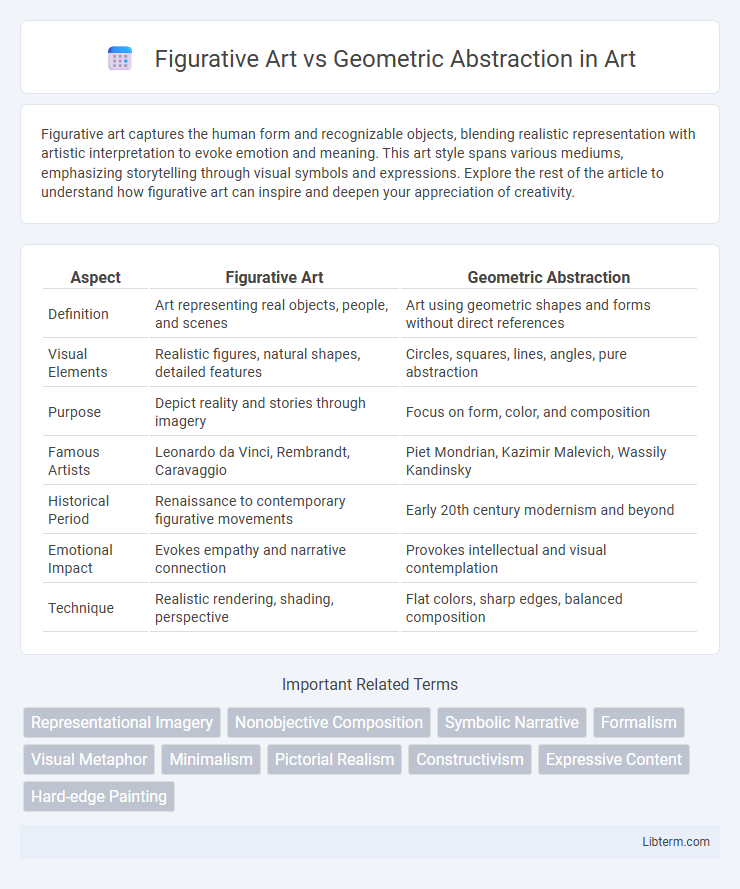Figurative art captures the human form and recognizable objects, blending realistic representation with artistic interpretation to evoke emotion and meaning. This art style spans various mediums, emphasizing storytelling through visual symbols and expressions. Explore the rest of the article to understand how figurative art can inspire and deepen your appreciation of creativity.
Table of Comparison
| Aspect | Figurative Art | Geometric Abstraction |
|---|---|---|
| Definition | Art representing real objects, people, and scenes | Art using geometric shapes and forms without direct references |
| Visual Elements | Realistic figures, natural shapes, detailed features | Circles, squares, lines, angles, pure abstraction |
| Purpose | Depict reality and stories through imagery | Focus on form, color, and composition |
| Famous Artists | Leonardo da Vinci, Rembrandt, Caravaggio | Piet Mondrian, Kazimir Malevich, Wassily Kandinsky |
| Historical Period | Renaissance to contemporary figurative movements | Early 20th century modernism and beyond |
| Emotional Impact | Evokes empathy and narrative connection | Provokes intellectual and visual contemplation |
| Technique | Realistic rendering, shading, perspective | Flat colors, sharp edges, balanced composition |
Understanding Figurative Art: Definition and Key Features
Figurative art represents real objects, especially human figures, using recognizable forms and narratives that evoke emotional connection and storytelling. Key features include realistic depiction, emphasis on anatomy, expression, and spatial depth to create lifelike representations. Unlike geometric abstraction, which relies on non-representational shapes and patterns, figurative art prioritizes visual references to the natural world and human experience.
What is Geometric Abstraction? Core Concepts Explained
Geometric abstraction is an art movement emphasizing non-representational shapes such as squares, circles, and triangles arranged in precise, often symmetrical compositions. Core concepts include the use of pure geometric forms, color theory, and spatial relationships to evoke emotion without depicting real-world objects. This style contrasts with figurative art, which relies on recognizable subjects and narrative elements to convey meaning.
Historical Origins of Figurative and Geometric Art
Figurative art originates from ancient prehistoric cave paintings and classical sculptures that emphasized human and animal forms to represent reality. Geometric abstraction emerged in the early 20th century with movements like Cubism and De Stijl, focusing on shapes, lines, and colors detached from recognizable subjects. Both styles reflect distinct historical contexts: figurative art rooted in traditional representation, while geometric abstraction signifies a modern break towards non-representational expression.
Leading Artists in Figurative Art
Leading artists in figurative art include Lucian Freud, Francis Bacon, and Alice Neel, whose work emphasizes realistic and emotionally charged depictions of the human form. These painters explore psychological depth through detailed representation, contrasting sharply with geometric abstraction's focus on non-representational shapes and forms. Figurative art's commitment to narrative and subject matter remains a defining characteristic that distinguishes it from the abstract, mathematical precision of geometric abstraction.
Influential Pioneers of Geometric Abstraction
Geometric abstraction emerged as a revolutionary art movement in the early 20th century, with pioneers such as Kazimir Malevich, whose Suprematism emphasized basic geometric forms and pure artistic feeling. Piet Mondrian advanced the style through Neoplasticism, focusing on horizontal and vertical lines and primary colors to express universal harmony. Wassily Kandinsky, although known for abstract expressionism, also contributed to geometric abstraction by exploring the spiritual and emotional impact of shapes and colors.
Visual Language: Representation vs. Abstraction
Figurative art employs a visual language centered on representation, capturing recognizable human forms and natural objects to convey narrative or emotion. Geometric abstraction utilizes shapes, lines, and colors in a non-representational manner, emphasizing structure, balance, and spatial relationships over realistic depiction. This contrast highlights figurative art's reliance on symbolic imagery versus geometric abstraction's focus on pure form and conceptual expression.
Techniques and Mediums in Both Art Forms
Figurative art employs techniques like chiaroscuro and linear perspective to create realistic representations using mediums such as oil paint, charcoal, and watercolor. Geometric abstraction relies on precise shapes and mathematical forms achieved through mediums like acrylics, collage, and digital tools, emphasizing flatness and color fields. Both art forms utilize varied textures and layering methods but differ fundamentally in the representation of reality versus conceptual geometry.
Emotional Impact: Interpretation and Viewer Response
Figurative art evokes emotional responses through recognizable subjects and expressive detail, enabling viewers to connect with human experiences and narratives on a personal level. Geometric abstraction relies on shapes, colors, and forms to provoke emotions by engaging perception and stimulating contemplation without representational cues. The emotional impact varies as figurative art invites empathy and storytelling, while geometric abstraction fosters introspection and a sense of harmony or tension through visual rhythm.
Figurative Art vs. Geometric Abstraction in Contemporary Practice
Figurative art in contemporary practice emphasizes recognizable subjects drawn from reality, often exploring identity, culture, and social narratives through human and natural forms. Geometric abstraction focuses on non-representational shapes, lines, and colors, prioritizing formal composition and spatial relationships over depiction. Both approaches coexist, with figurative art anchoring meaning in tangible imagery while geometric abstraction challenges viewers to interpret visual language through pure form and structure.
Collecting and Valuing: Market Trends and Investment
Figurative art continues to appeal to collectors valuing emotional narrative and recognizable subjects, often commanding premium prices at auctions due to its timeless appeal and artist provenance. Geometric abstraction has gained momentum among contemporary art investors seeking innovation and minimalism, with market trends showing increased demand through online platforms and modern galleries. Collecting both styles diversifies investment portfolios, balancing traditional market stability with cutting-edge artistic movement potential.
Figurative Art Infographic

 libterm.com
libterm.com